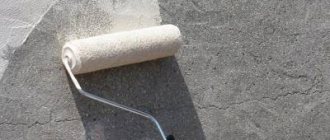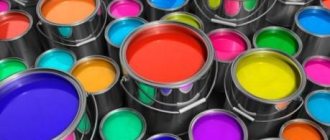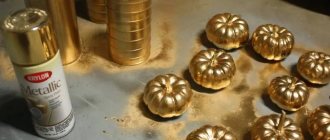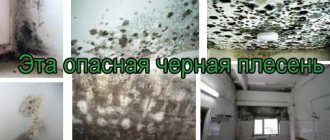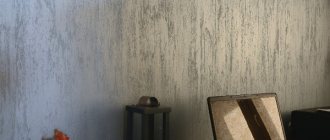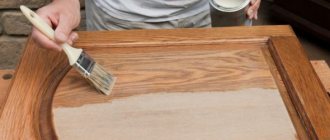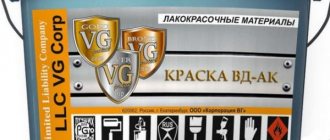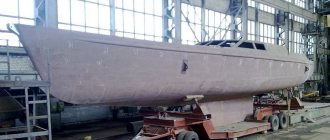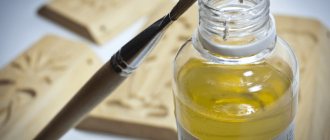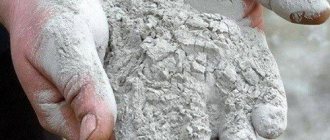Materials and tools for work
Before you start painting the foundation of a cement house, you should prepare everything you need.
To apply paint you will need:
- different brushes and rollers with bristles, as they are more resistant to wear from contact with concrete;
- wire brush, water hose;
- shovel;
- individual protection means.
To prepare the surface for painting, you will need cement to seal cracks and chipped areas. In addition, it is necessary to prepare a primer mixture to reduce the absorption of the concrete surface, thereby reducing paint consumption.
You will also have to decide what is the best way to paint the foundation of the house, calculate the need for a paint composition, taking into account the characteristics of the material and its approximate consumption.
What colors to paint a concrete foundation
The foundations that serve as the foundation for any home always need protection from destructive external factors, regardless of what material is used for their manufacture. If such a material is concrete, then the main reason for its destruction will be corrosion, that is, the formation of microcalcite in the form of dust from carbon dioxide and lime. This greatly reduces the strength of the outer layer of concrete, regardless of its brand. Painting is often used as an anti-corrosion agent for concrete bases.
Requirements for paints
Today, ready-made latex paint for foundation plinths is produced in the form of a concentrated composition that requires dilution with water or solvents in a certain proportion. It is important to read the recommendations on the packaging.
The principle of interaction between paint components and foundation materials is clear - to create maximum adhesion for the protective film. It should also:
Summarizing all these factors, it becomes clear that the ideal paint for a concrete foundation should be, at a minimum, frost-resistant, moisture-resistant and vapor-permeable. Additional properties are environmental friendliness, practicality and durability.
If there is a large supply of paint left, you can use it to treat other surfaces that require protection:
- Blind area;
- Facade decor;
- Fences and fences;
- External stairs;
- Verandas and gazebos;
- Garden path edges;
- Poles for lighting gardens and areas.
Cost of materials
Despite the fact that on the websites the paints are written at the same price, together with delivery to the regions of the Russian Federation it can cost much more. The price also depends on the amount of material in the package, composition and manufacturer.
Rubber paint costs from 650 rubles. Simple facade paint sells for 110 rubles. Acrylic paints (2.5 kg) are sold at a price of 950 rubles. Latex paints are sold from 80 rubles. The most expensive is heat-resistant paint, sold in 12 kg packages. Its cost is 7,800 rubles.
As for the cost of painting the base, in the Russian Federation it starts from 150 rubles per 1 m2.
Materials and tools for work
For craftsmen who have confident painting skills, painting the basement of a house will not be difficult. You will need standard tools:
- Bayonet shovel for cleaning dirt;
- A hard metal brush for cleaning off deposits;
- Paint brushes and roller with attachments;
- Construction spray gun;
- Set of spatulas (trowel).
Kawabanga!
Do-it-yourself finishing of a concrete staircase with wood in a country house. The set of tools may vary slightly, depending on the conditions of the work and the degree of neglect of the old foundation. A hose for rinsing under running water, brooms and brushes may be useful.
Let's look at the properties of paints for concrete
Acrylic paints
Silicone paints
Due to the high degree of elasticity, no additional surface tension is created, which significantly extends the life of the paint. In addition, it perfectly withstands the influence of ultraviolet radiation, without fading and maintaining its attractiveness.
Epoxy paint
The cost of this type is quite high, but with the help of this material it is possible to protect the base not only from atmospheric influences, but also from mechanical damage.
Polyurethane paint
To achieve maximum durability, it is necessary to apply the paint in two layers. The second one needs to cover the surface after the first one has dried. Within a week the base will gain mechanical strength, and after two weeks it will become resistant to aggressive influences.
Silicate
However, there are also disadvantages to silicate paints. Among the main ones are a long drying period and a low coefficient of vapor permeability.
Alkyd
Despite the high resistance to ultraviolet radiation, it is necessary to periodically renew the surface. This should be done approximately once every three years.
Oily
This paint has a very attractive appearance and is consumed very economically, while the cost of such a paint coating is quite reasonable, which makes it not only reliable, but also profitable.
Cement
Any of the listed paint and varnish materials can make the base attractive, while providing it with additional protection from the influence of external factors. But this is only possible if the application technology is followed.
What properties should concrete paint have?
Since concrete walls are quite capricious, the requirements for dyes for such surfaces should be increased:
- adhesive properties. Facade paints must have a high penetrating ability for deep adhesion to the surface. To improve these properties of painting materials, it is recommended to prime the surface before painting;
- moisture resistance. Considering the ability of a concrete coating to absorb moisture, manufacturers add special additives to painting materials that can repel water. The higher this ability, the better the paint;
- wear resistance. An important indicator that characterizes the service life of the dye is its abrasion. The more aggressive influences a coloring material can withstand, the higher its endurance rating;
- resistance to solar radiation. Ultraviolet radiation negatively affects the color pigment of the paint: with a low sun resistance, the paint quickly loses its color saturation, brightness and attractiveness, and can peel off. Exterior paints must have high resistance to sunlight;
- vapor permeability. The chemical composition of paints must be designed in such a way as to have the ability to release accumulated moisture. Considering that concrete easily absorbs moisture, if the coating is completely sealed, it will accumulate between the surface and the coating, which will lead to the destruction of the dye and base during temperature fluctuations;
- resistance to pollution. Most paints have good stain resistance: they are not able to absorb dirt and are easy to clean. The smoother the painted surface, the less susceptible it will be to the accumulation of dust and dirt;
- drying time. Drying the outer paint material as quickly as possible ensures the least chance of exposure to rain; the faster the paint dries, the better;
- consumption per 1m2. Concrete requires a large consumption of dye, so you should start from the characteristics of the chosen paint;
- saturation. The indicator is directly related to consumption: the higher the saturation, the lower the consumption. The concrete base requires complete painting, since the gray reflections of the coating are not aesthetically pleasing and unattractive.
NOTE! Due to the increase in strength and wear resistance, exterior paints may contain some elements harmful to health.
In this regard, it should be borne in mind that such paints are not suitable for indoor use.
Technology for painting the base
When paint for facades and plinths has been selected, you should study the features of its application. Manufacturers usually indicate the characteristics of coloring using the composition. But there is also a general technology for applying paint to the surface.
Surface cleaning
Sealing cracks and leveling the surface
Sealing cracks
If you need to create a more durable solution, you can add a plasticizer to it. 2 days after embedding, they begin leveling the base. Further procedures are carried out after the solution has completely dried.
Surface primer
The primer is applied to a dry surface. It is important to coat the plinth thoroughly so that the compound penetrates into every crevice. This guarantees perfect paint adhesion. You can cover the wall with two layers of primer.
Primer work
This is due to the fact that after the first application the primer is almost completely absorbed by the base. You can coat the base with a primer using a brush or roller.
Kawabanga! How and with what to paint concrete surfaces
Painting the base
Final coloring
Each subsequent layer is applied after the previous one has dried. Typically, the time when the base can be coated with the next layer is indicated by the manufacturer.
A painted base is not only beautiful, but also reliable. Correctly selected composition and adherence to the technology of its application will help prevent damage to the surface from the influence of external factors.
In addition, a large abundance of paints and varnishes makes it possible to embody original design ideas, where the base will become an integral element of the overall picture of the facade.
Why is it necessary to protect the foundation/basement?
Concrete is one of the strongest and most durable building materials - it was used in the construction of the Roman Pantheon. And yet it does not last forever. Concrete, like any other building material, is subject to corrosion caused by exposure to atmospheric conditions. The following types of concrete corrosion are distinguished:
- Leach corrosion – caused by very soft water that contains few salts. Clean and soft water from precipitation or melting ice has the character of distilled water and is considered an aggressive medium that has a detrimental effect on concrete. Corrosion occurs as a result of the dissolution and leaching of calcium hydroxide (CaCO3). Concrete exhibits the greatest sensitivity to destruction of this kind in the first period after production, when the calcium hydroxide it contains has not yet crystallized well. Leach corrosion is especially dangerous when water is in motion (melting ice, heavy rainfall).
- General acid corrosion - caused by acidic water. Unfavorable and even dangerous waters for concrete are those whose pH is less than 4.0, as well as those that contain salts of very strong acids. The aggressive action of acidic waters is to remove calcium hydroxide and then, when it is reduced or removed, to decompose hydrated silicates and aluminates. Acidic waters can attack not only the binder (cement), but also crushed stone and steel in reinforced concrete.
- Carbon corrosion - is explained by the presence of aggressive carbon dioxide in the air and water, which is present in excess relative to the amount necessary to create calcium carbohydrates and maintain it in solution. Free carbon dioxide can initiate destructive reactions in several components of the fresh solution.
- Sulfur corrosion is the most common and dangerous for concrete. It consists of the formation in the pores of concrete of poorly soluble salts, which are characterized by a significant increase in volume, leading to stress concentration and sometimes destruction of concrete. As a result of the action of sulfate acids, gypsum or ettringite is formed.
- Chloride corrosion - occurs as a reaction to exposure to sea water, mine water, and various deicers. As a result of this influence, double salts are formed, causing numerous destructive processes in the structure of concrete.
Collapsed concrete
Concrete and fuels and lubricants, as well as their decomposition products, have a detrimental effect. Therefore, any concrete, regardless of its brand, needs protection. And if the underground part is protected by waterproofing, then protecting the foundation base requires additional measures. One of the most common methods of protection is painting the foundation with special paints.
However, attention should be paid to the fact that not only corrosion is the cause of destruction of concrete structures. Damage to concrete products can also occur as a result of exceeding the maximum stress, increasing load, operational or mechanical factors (impact, overload, building subsidence, vibration).
The best paint for the base
When deciding how to paint a concrete foundation, you should take into account the surface material of the building structure, local climatic conditions, cost, durability, surface application technology and the desired color shade.
How to paint the foundation of a house for a beautiful appearance? Depending on your financial capabilities, use alkyd or polyurethane paints. Among the colors and textures offered on the market, you are sure to find the best option.
To coat surfaces made of porous materials, silicone paints must be used. No other paint can provide them with a higher level of protection.
Do not forget about preliminary priming of the surface. This operation improves surface adhesion and ensures the durability of the paintwork. Therefore, when purchasing paint, do not forget to purchase the appropriate primer.
Paint coatings used
Today, many companies produce products for treating the base. These paints and varnishes must be diluted with a special solvent or water. The instructions also state that for best results, use a primer from the same manufacturer.
How to choose the right paint?
- The most popular are acrylic paints that require dilution. They can be easily applied to concrete, stone and brick. After processing, the materials become moisture resistant, but remain breathable. Such paints are frost-resistant and practically do not fade.
- Alkyd or polyurethane paints contain special solvents of synthetic or organic origin and do not react to temperature changes. They are not afraid of mechanical damage, ultraviolet radiation and moisture. If applied with a suitable primer they will last a very long time.
- Highly porous surfaces are treated with silicone compounds. Such paints can be applied to newly constructed basement walls or used in the restoration of old structures. The higher price of this product is justified by its excellent quality. Silicone compounds do not prevent air circulation, but they repel moisture.
- Polyvinyl acetate paints with an adhesive base are diluted with water. This is the cheapest product for painting a house, but it wears out very quickly. Re-preparing the base for painting may damage the material. As a result, major renovation work will be required.
- Enamel compositions are based on resin, varnish or polymers. Solvents must be added to them. Their advantages include durability, absolute moisture resistance and beautiful gloss. Enamel paints are available in a wide range of bright colors. The disadvantages are that they are considered unsafe for health and have poor air permeability.
- If it is necessary to protect the surface from high temperatures, we recommend using fire retardant paint for metal. It is applied to an iron base (profiled sheet, metal siding). The base, which has been treated with such paint, will withstand even strong heat.
The shelf life of the paint is 2 years. It should be stored in a tightly closed container away from sources of fire. To ensure that the product does not lose its quality, it should be placed in a dark place. Heat and direct sunlight are detrimental to the composition of the paint.
Please note that only moisture-resistant compounds are suitable for external work. Treating a house with water-based paint is pointless - the coating will not withstand the first rainfall. At the same time, high-quality waterproof paint, if applied correctly, will last at least 4 years.
The vapor permeability of the coating also plays an important role. Not only the paint, but also the primer should have this property. Most paints have the ability to block carbon dioxide. This protects the walls from salt deposits and unsightly whitish stains.
Thanks to the special properties of base paints, they are a multifunctional product. In addition to painting the base and facade, they can be used to treat any rooms with high humidity. For example, they would be ideal for painting an underground garage or drainpipes.
Coloring protects the material from moisture, salts and biological influences.
Types and characteristics of paints for protecting the base
For the lower part of the building, it is recommended to use the following types of paint for the plaster plinth:
- acrylic, diluted with water;
- alkyd, based on natural and synthetic solvents;
- silicone based;
- epoxy;
- polyurethane.
Acrylic paints
Alkyd paint and varnish compositions
Silicone based paints
Epoxy paints
They are the strongest and most durable. Ensures complete sealing of the coating. They consist of an epoxy base, a coloring pigment and a hardener, which is added to the composition just before application to the surface.
Epoxy paint can protect the base not only from precipitation, but also from strong mechanical influences. The main disadvantage of the material is its high cost.
Polyurethane coloring compounds
Features and advantages of various paints and varnishes
Scheme of basement waterproofing.
To cover the base of a house, you can use various types of paint and varnish products. Each coating has its own characteristics and disadvantages. First of all, it should be noted that all of them are characterized by high adhesion, i.e. have excellent adhesion to the surface being treated, which ensures the durability of the coating.
Both smooth and textured paints are suitable for finishing the basement of a house. To finish the surface with textured paint, you must use a roller. This type of painting allows you to make the appearance beautiful and original. Matte paint will reflect the sun's rays, which will hide minor surface defects.
Water-dispersion paint provides reliable protection for the base of the house from any vagaries of nature and makes it almost invulnerable. Paint and varnish materials also differ in composition. Available to the consumer:
- Organic based compositions.
- Water-based compositions.
If we talk about water-soluble paints, then these are water dispersions and various emulsions of synthetic resins. These include:
Scheme of a concrete plinth.
- Latex.
- Silicone.
- Acrylic.
- And others.
Organic-based paints are alkyd and polyurethane. Considering in more detail the paint and varnish materials available today, it is necessary to briefly describe each of them.
Before painting the base of the house with acrylic paint, the working surface must be cleaned of dirt and dust using a stiff brush or washed with water from a hose. When finishing, you must strictly follow the manufacturer's instructions given on the packaging. This paint has a number of advantages, including:
- High strength.
- Reliable wind protection.
- Protection from various types of chemical influences.
Water-soluble paints have the most environmentally friendly properties; they are also suitable for interior decoration. This type of paint is the easiest to work with. Latex water-based compositions have increased moisture resistance. This allows you to wash your work surface frequently. The paint provides good protection for concrete against corrosion.
Epoxy compounds provide high protection against negative mechanical influences. By using this option, you will ensure durable and reliable painting of the base. A separate advantage of this paint is the ability to apply it to fresh and wet concrete. Painting is carried out in 2 mandatory stages with a difference of 12-24 hours. Polyurethane painting, in addition to a very long service life, guarantees the impossibility of dirt “sticking” to the surface and provides reliable protection of the base from the appearance of fungus and mold.
Instructions for painting the base
After selecting and purchasing paint with the appropriate primer, you can begin painting the surface of the basement of the building. They include the following steps:
- cleaning from dirt and mold;
- primary priming;
- sealing cracks and leveling the surface;
- second soil treatment;
- coloring.
Tools for painting work you will need:
- paint brushes, roller or spray gun;
- paint roller tray or other wide container;
- spatula, wire brush, hammer and chisel;
- trowel, grater and short plastering rule.
In addition, you should prepare a tool for possible mechanical removal of mortar residues and other contaminants.
Surface cleaning
Sealing cracks and leveling the surface
Before painting the base, it is necessary to repair the cracks and level it. Before performing this work, the base should be treated with deeply penetrating primer. This will bind any remaining dust particles and strengthen the concrete or brick surface.
Work on sealing cracks must be done with a cement-sand plaster mortar prepared in a ratio of 1:4. To improve the quality, it is recommended to add a plasticizer or liquid detergent to the solution.
Painting the base
Before painting, the surface must be treated with primer again twice and allowed to dry for 24 hours. This will strengthen the places where the leveling layer is applied.
Kawabanga! Concrete repair using injection method
Painting scheme with a spray gun.
Painting the foundation
Features of restoration work
New walls require minimal preparation. You just need to wait until they are completely dry before priming and painting. Restoration is a longer and more labor-intensive process. In order for it to be successful, you need to be especially careful.
- First, carefully inspect the walls, clean off all crumbling fragments. Wipe off dust and dirt. All metal parts must be removed, as they do not allow the paint to adhere tightly to the facade.
- Prime the prepared walls and dry them.
- Next, the facade is painted using a wide brush or roller. If you want to make the surface textured, use a roller with long, hard bristles. Thick paint for the base, which has not been diluted, can add texture.
If you have installed a plaster facade system for insulating the house or waterproofing, the work of painting the base is carried out as described above.
All modern base finishing products have similar properties. But that doesn't mean their choice is easy. Take the time to learn the special properties of primers and paints. This will save you from many problems associated with caring for your home.
Types of paints for concrete
- high and low temperatures (and their differences);
- humidity changes;
- exposure to precipitation;
- UV radiation and air pollution.
You can choose a color to suit your taste
The paint for the base must withstand both the action of all these factors at the same time, and the intense impact of one of them, for example, constant sun rays on a sunny southern façade.
Coatings designed specifically for concrete include acrylic, silicone, epoxy, polyurethane, silicate and alkyd paints. Budget option - oil, cement.
Acrylic paints
They can be recommended for protecting concrete products, fiber-cement slabs and plinths from moisture. Given their low vapor permeability, acrylic paints are not suitable for silicate substrates and lime plaster.
Concrete that is to be painted with acrylic paint must be primed with a primer from the same manufacturer. In addition to creating a high-quality coating, this protects the surface from the penetration of moisture and salt.
Silicone paints
Epoxy paint
These materials require careful cleaning and surface treatment. Suitable solvents are esters, ketones, aromatic hydrocarbons and alcohols are used as solvents.
The influence of the atmosphere is manifested in the loss of gloss of the coating, but this feature does not weaken the anti-corrosion properties of the coating, which is very important for concrete paint for foundations.
Polyurethane paint
Due to its properties, it is ideally suited for exterior work and painting the foundation/basement.
Silicate
Schwyz – town hall painted with silicate paint
Silicate paint is considered very durable and weather resistant. Its service life significantly exceeds one hundred years. An example is the town hall in the city of Schwyz in Switzerland, covered with such a coating in the 19th century.
Painting with silicate paints requires skill and experience, since liquid glass destroys metal and ceramic tiles. So it is better to entrust painting work with this material to a specialist.
Alkyd
Oily
It should be applied to a completely dry, pre-primed base - concrete or plaster.
Types of paints
The problem of how to paint a concrete foundation can be easily solved today - the construction market offers a sufficient selection of materials necessary for this, each of which creates protection for the surface in a certain way.
The choice of paint depends on the type of foundation surface, which can be “clean” or finished with plaster. Based on this feature, paints can be mineral or organic.
Acrylic
The compositions are emulsion, and after final drying they are resistant to being washed off by water. With this composition, a flexible and stain-resistant layer is formed that has excellent adhesion to the surface. The material is based on acrylic resin, sometimes replaced with latex. This paint is recommended for concrete, fiber cement board and basement. Due to the low level of vapor permeability, acrylic paint should not be used on silicate surfaces and lime plaster layers. The concrete base is pre-primed with a composition of the same brand.
Silicone
It is made on the basis of silicone resin, after application it does not form an impermeable membrane, it has good vapor permeability and resistance to moisture. Some coloring compositions of this group have self-cleaning properties and remain clean and dry after rains. The compositions are excellent for painting the plastered foundation of a house, brickwork or concrete surface; they are used on bases previously painted with silicate compounds.
Epoxy
The paint consists of two components that dry due to a chemical reaction between them, combined immediately before application in established volumetric or weight proportions. Having reached final drying, the paint becomes a reliable protective layer against moisture, oils, solvents and chemical compounds. Epoxy paints are known for their excellent adhesion and high mechanical properties.
Before using them, the surface is thoroughly cleaned and treated.
Polyurethane
The composition is two-component. In terms of its adhesion capabilities, resistance to moisture and solvents, and the strength of the created layer, it has much in common with epoxy paints. If you are in doubt about how to paint the outside of your house’s foundation, pay attention to this type of material.
Silicate
The binding element is potassium glass in a liquid state, combined with dyes in a dry or dissolved state. The silicate coloring composition does not create a film; when connected to the surface, it adheres to it firmly. The covering layer is even, but allows air to pass through. In addition, it protects against the formation of mold and mildew. The paint is recommended for surfaces made of concrete and brick; it “works” on a base painted with an inorganic composition. The material applies well to a damp base.
Its use requires the necessary experience, so it is best to entrust the work to a master.
Alkyd
This paint is used more often than other types; it has earned its popularity due to its reasonable cost. The main component is oil. The properties of such paints can be easily changed by adding appropriate ingredients. Phenolic or silicone resins improve shine, silicone adds water and UV resistance. Due to the oil content, the paint creates a good shine after application, dries quickly, and creates an elastic coating that is resistant to atmospheric conditions. If you are in doubt which paint for the foundation is better, here is an excellent solution to the problem.
Oily
It dries slowly, the consistency resembles a paste or liquid with pigment particles. It is used in the construction industry and other industrial sectors as a protective or decorative coating. Don’t know how to properly paint the foundation with this composition? Pre-dry its surface and coat it with a primer.
Cement
Another paint for a concrete foundation, the basis of which is a mixture of light-colored cement mass, pigments and polymers, which give the layer flexibility and improve adhesion. This version of façade paint is considered the cheapest, provides excellent protection from moisture, allows air to pass through, but has a short service life. Recommended for application on plastered, reinforced concrete or stone surfaces.
